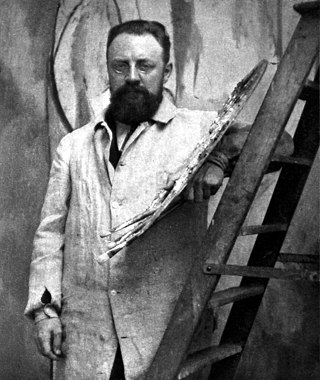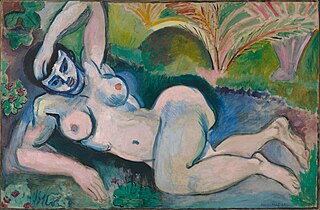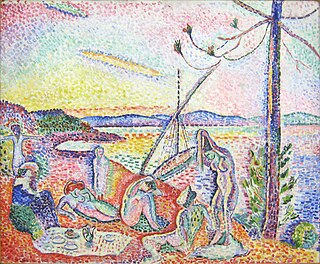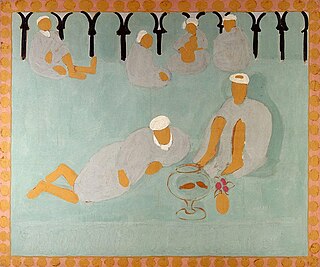
Henri Émile Benoît Matisse was a French visual artist, known for both his use of colour and his fluid and original draughtsmanship. He was a draughtsman, printmaker, and sculptor, but is known primarily as a painter. Matisse is commonly regarded, along with Pablo Picasso, as one of the artists who best helped to define the revolutionary developments in the visual arts throughout the opening decades of the twentieth century, responsible for significant developments in painting and sculpture.

Thomas K. Wesselmann was an American artist associated with the Pop Art movement who worked in painting, collage and sculpture.

Les Demoiselles d'Avignon is a large oil painting created in 1907 by the Spanish artist Pablo Picasso. Part of the permanent collection of the Museum of Modern Art in New York, it portrays five nude female prostitutes in a brothel on Carrer d'Avinyó, a street in Barcelona, Spain. The figures are confrontational and not conventionally feminine, being rendered with angular and disjointed body shapes, some to a menacing degree. The far left figure exhibits facial features and dress of Egyptian or southern Asian style. The two adjacent figures are in an Iberian style of Picasso's Spain, while the two on the right have African mask-like features. Picasso said the ethnic primitivism evoked in these masks moved him to "liberate an utterly original artistic style of compelling, even savage force” leading him to add a shamanistic aspect to his project.

Louis Vauxcelles was a French art critic. He is credited with coining the terms Fauvism (1905) and Cubism (1908). He used several pseudonyms in various publications: Pinturrichio, Vasari, Coriolès, and Critias.

Albert Marquet was a French painter, associated with the Fauvist movement. He initially became one of the Fauve painters and a lifelong friend of Henri Matisse. Marquet subsequently painted in a more naturalistic style, primarily landscapes, but also several portraits and, between 1910 and 1914, several female nude paintings.

Blue Nude (Souvenir of Biskra) (French: "Nu bleu, Souvenir de Biskra"), an early 1907 oil painting on canvas by Henri Matisse, is located at the Baltimore Museum of Art as part of the Cone Collection.

Dance (La Danse) is a painting made by Henri Matisse in 1910, at the request of Russian businessman and art collector Sergei Shchukin, who bequeathed the large decorative panel to the Hermitage Museum in Saint Petersburg, Russia. The composition of dancing figures is commonly recognized as "a key point of (Matisse's) career and in the development of modern painting". A preliminary version of the work, sketched by Matisse in 1909 as a study for the work, resides at MoMA in New York City, where it has been labeled Dance (I).

Le bonheur de vivre is a painting by Henri Matisse. Along with Picasso's Les Demoiselles d'Avignon, Le bonheur de vivre is regarded as one of the pillars of early modernism. The monumental canvas was first exhibited at the Salon des Indépendants of 1906, where its cadmium colors and spatial distortions caused a public expression of protest and outrage.

The Matisse Museum is a museum in Le Cateau-Cambrésis, France that primarily displays paintings by Henri Matisse. The museum was established by Matisse himself on 8 November 1952; he also defined the way his works should be arranged. At that time the museum was located in the wedding room of the Le Cateau City Hall.

Luxe, Calme et Volupté is a 1904 oil painting by the French artist Henri Matisse. Both foundational in the oeuvre of Matisse and a pivotal work in the history of art, Luxe, Calme et Volupté is considered the starting point of Fauvism. This painting is a dynamic and vibrant work created early on in his career as a painter. It displays an evolution of the Neo-Impressionist style mixed with a new conceptual meaning based in fantasy and leisure that had not been seen in works before.

Fauvism is the style of les Fauves, a group of early 20th-century modern artists whose works emphasized painterly qualities and strong colour over the representational or realistic values retained by Impressionism. While Fauvism as a style began around 1904 and continued beyond 1910, the movement as such lasted only a few years, 1905–1908, and had three exhibitions. The leaders of the movement were André Derain and Henri Matisse.
The Piano Lesson depicts the living room of Henri Matisse's home in Issy-les-Moulineaux, with his younger son, Pierre, at the piano, the artist's sculpture Decorative Figure (1908), at bottom left, and, at upper right, his painting Woman on a High Stool. Matisse began with a naturalistic drawing, but he eliminated detail as he worked, scraping down areas and rebuilding them broad fields of color. The painting evokes a specific moment in time—light suddenly turned on in a darkening interior—by the triangle of shadow on the boy's face and the rhyming green triangle of light falling on the garden. The artist's incising on the window frame and stippling on the left side produce a pitted quality that suggests the eroding effects of light or time, a theme reiterated by the presence of the metronome and burning candle on the piano.

Proto-Cubism is an intermediary transition phase in the history of art chronologically extending from 1906 to 1910. Evidence suggests that the production of proto-Cubist paintings resulted from a wide-ranging series of experiments, circumstances, influences and conditions, rather than from one isolated static event, trajectory, artist or discourse. With its roots stemming from at least the late 19th century, this period is characterized by a move towards the radical geometrization of form and a reduction or limitation of the color palette. It is essentially the first experimental and exploratory phase of an art movement that would become altogether more extreme, known from the spring of 1911 as Cubism.
Sophie Alexina Victoire Matisse is an American contemporary artist. Matisse initially gained notice for her series of Missing Person paintings, in which she appropriated and embellished upon, or subtracted from, recognizable works from art history.

Baigneuses, also called Bathers, is a Proto-Cubist painting, now lost or missing, created circa 1908 by the French artist and theorist Jean Metzinger. Possibly exhibited during the spring of 1908 at the Salon des Indépendants. This black-and-white image of Metzinger's painting, the only known photograph of the work, was reproduced in Gelett Burgess, "The Wild Men of Paris", Architectural Record, May 1910. The painting was also reproduced in The New York Times, 8 October 1911, in an article titled "The 'Cubists' Dominate Paris' Fall Salon", and subtitled, "Eccentric School of Painting Increases Its Vogue in the Current Art Exhibition - What Its Followers Attempt to Do".
Lydia Nikolaevna Délectorskaya was a Russian refugee and model best known for her collaboration with Henri Matisse from 1932 onwards.
Bathers by a River, also known as Bathers at the River and occasionally referred to as simply Bathers, is a large 1917 oil-on-canvas painting by French artist Henri Matisse. Matisse began painting the canvas in 1909 and finished the painting in the fall of 1917, making it one of three pictures he painted during the Battle of Verdun.

French visual artist Henri Matisse was known for his use of color and draughtsmanship. In the early 20th century, Matisse became a leader of the Fauvism art movement, which was an early movement in the broader Post-impressionist era.

Arab Coffeehouse, is an oil-on-canvas painting by French visual artist Henri Matisse. Produced in 1913, Arab Coffeehouse was part of a series of goldfish paintings that Matisse produced in the 1910s and 1920s.














